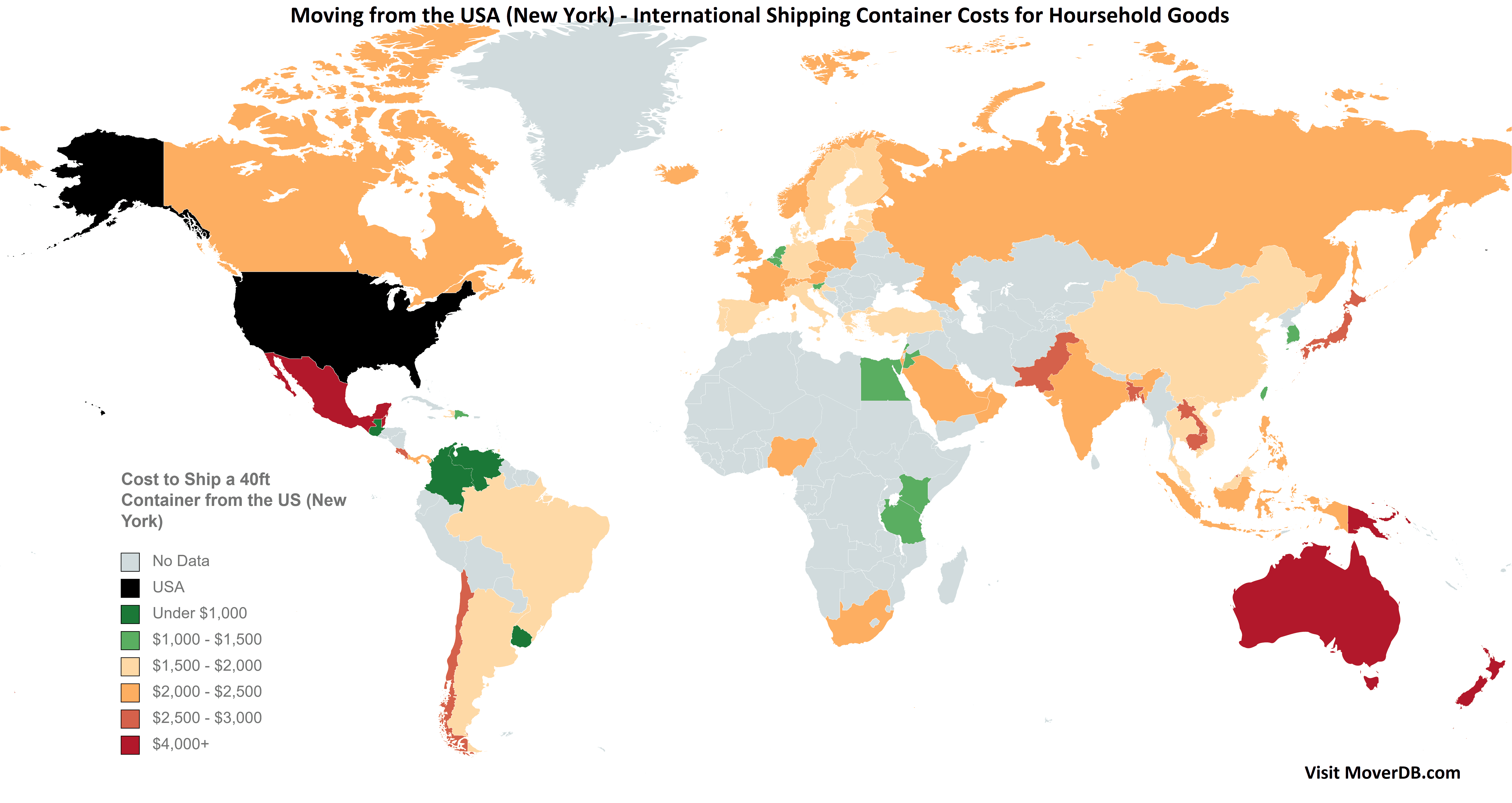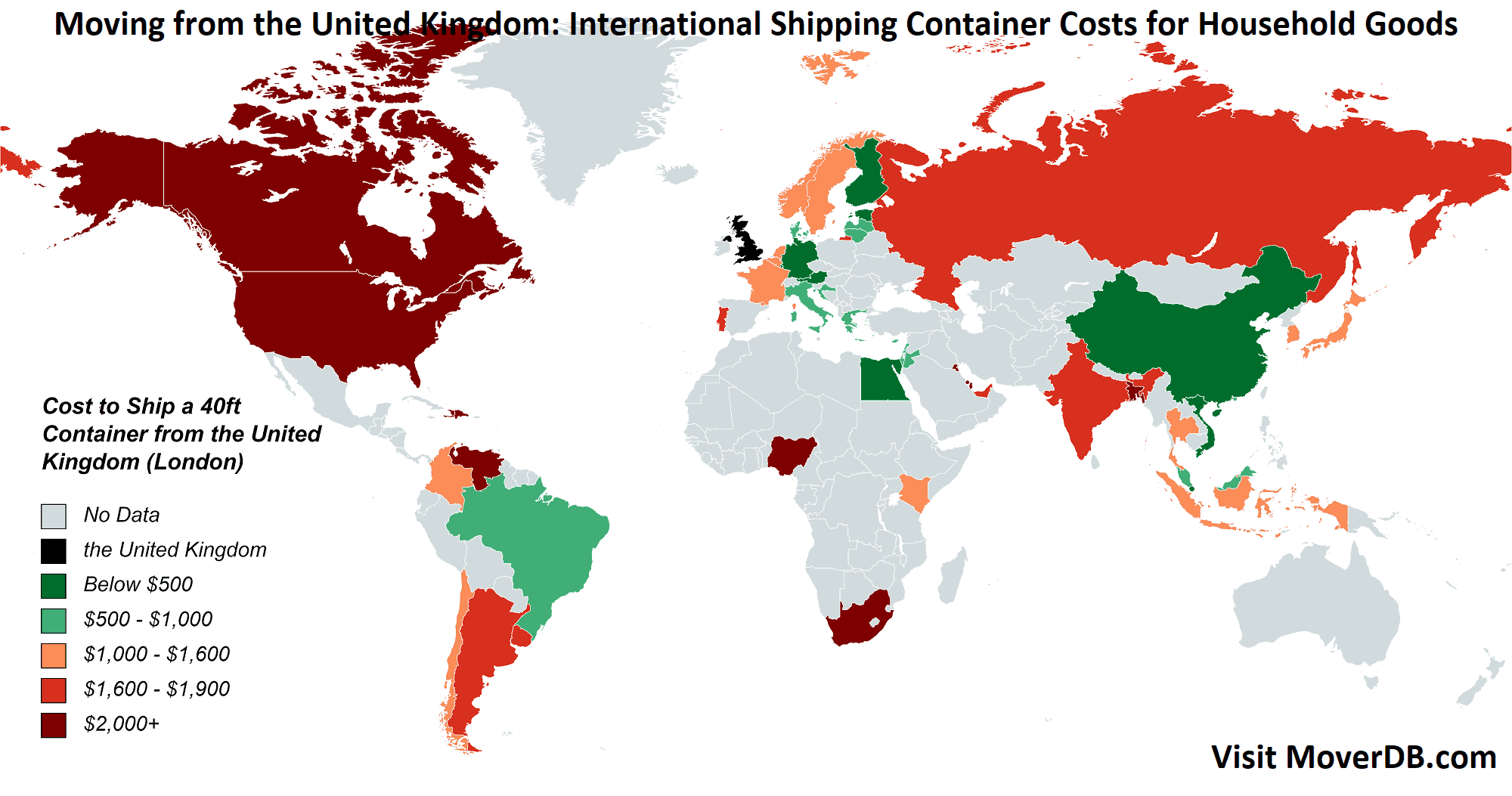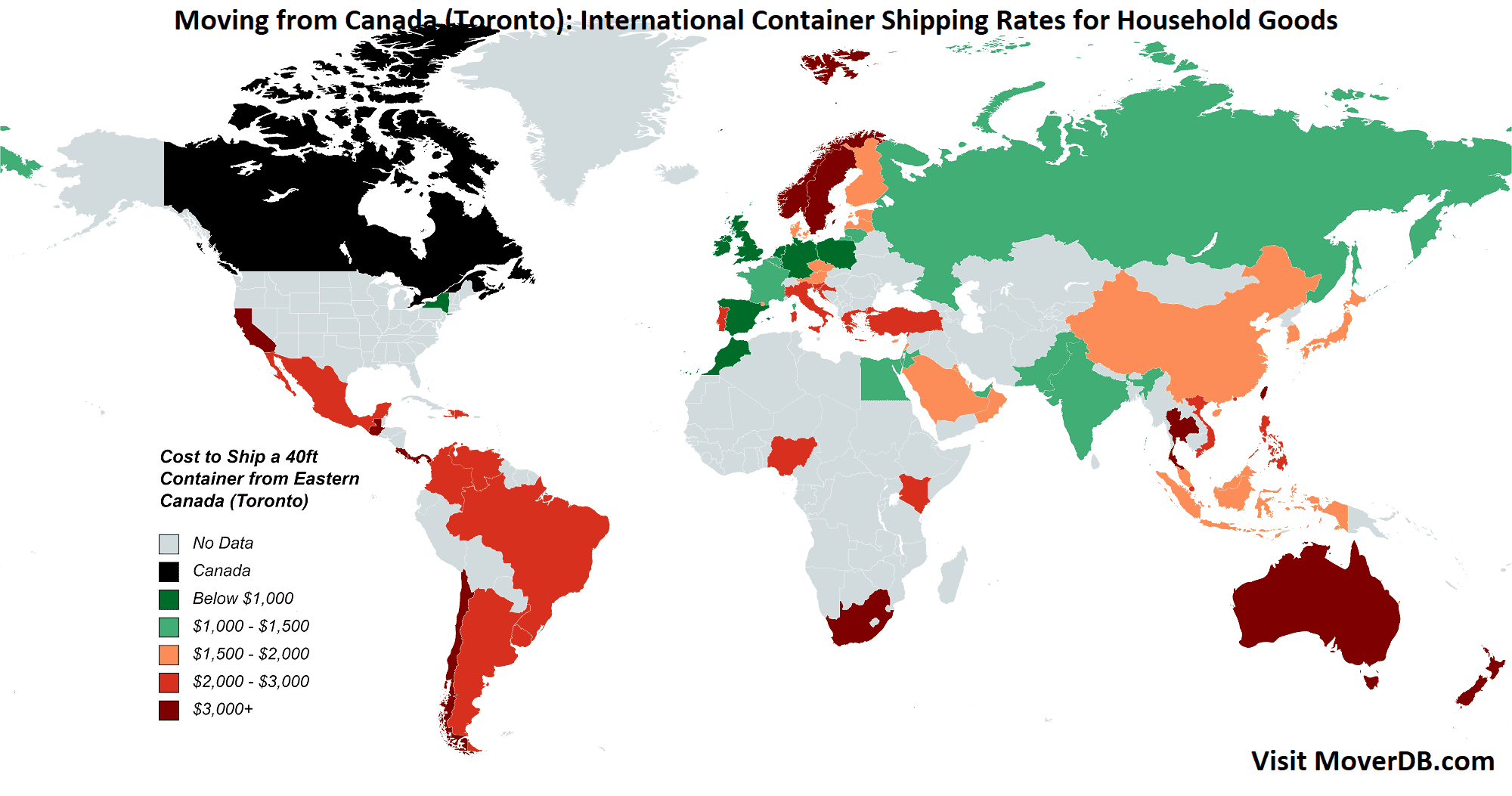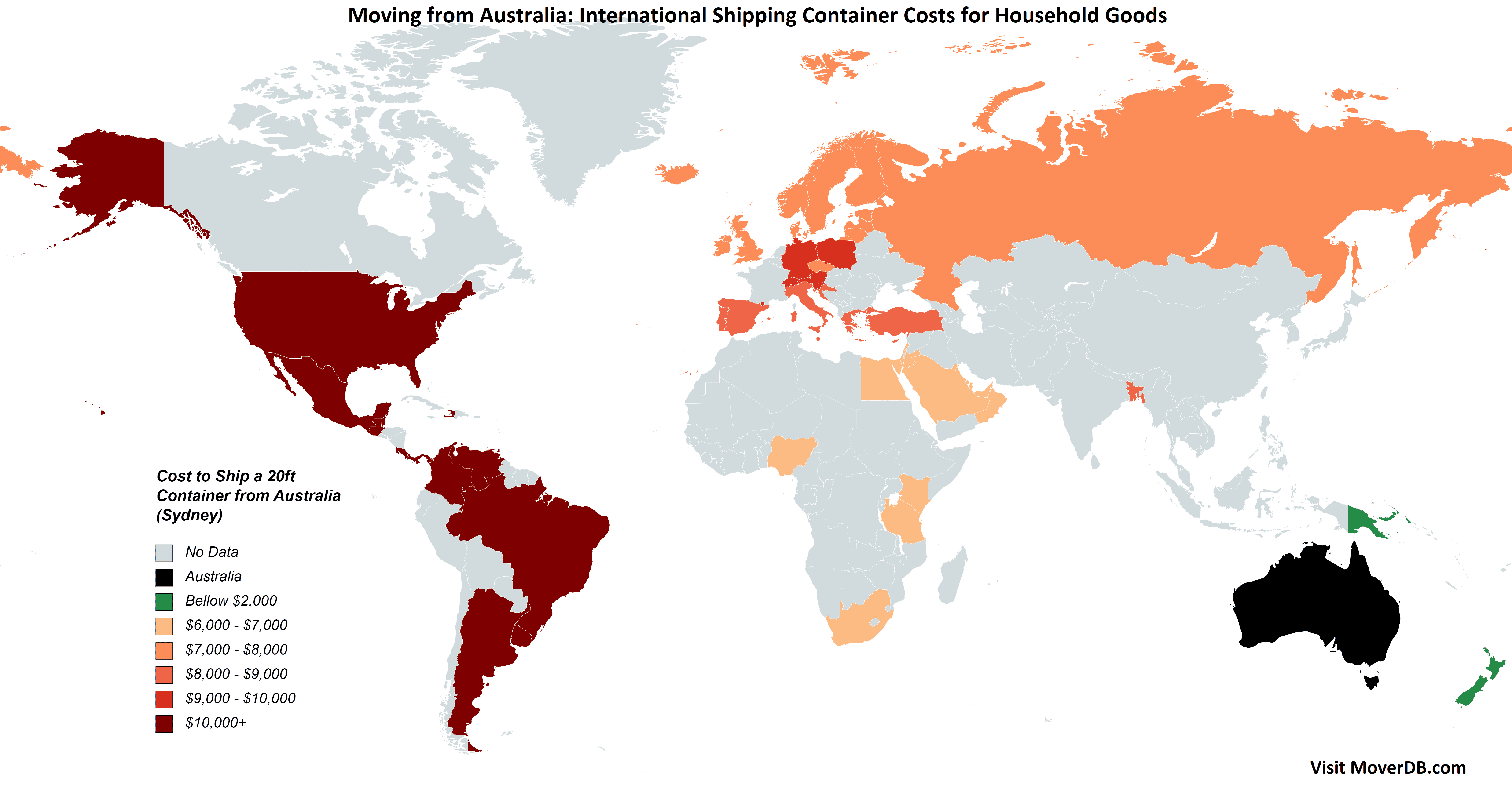International container shipping rates are extremely volatile right now primarily because of the ongoing situation in the Red Sea.
Nevertheless, Container shipping remains by far the cheapest way to ship goods internationally, but prices vary widely between where you’re moving from and where you’re moving to.
You can get the most accurate and up-to-date data by using the quote form at the top of this page.
Container Shipping Rates Chart January 2024
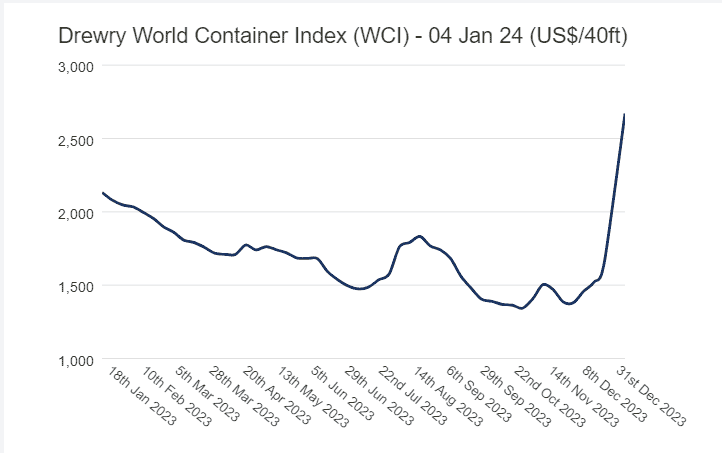
Container Shipping Rate Highlights
- Container shipping rates fell in 2023 but are now rising sharply in early 2024.
- For example, cost of the the Shanghai-Rotterdam and Shanghai-Genoa routes are both up over 100% in the last week.
- Drewry’s World Container Index puts the global average price of shipping a 40ft container at $2,670 (USD) for 4 January 2024.
- Whereas the Freightos Baltic Global Freight Index (FBX) put the cost of shipping a 40ft container even lower at just $1,341.00. although it’s likely this data does not take into account recent developments.
Here are some highlights from rates on major shipping routes for a 40ft container courtesy of Drewery Supply Chain Advisors:
| Route | Route code | 4 Jan Rate | Annual change (%) |
|---|---|---|---|
| Composite Index | WCI-COMPOSITE Index | $2,670 | Up 25% |
| Shanghai – Rotterdam | WCI SHA – RTM | $3,577 | Up 91% |
| Rotterdam – Shanghai | WCI RTM – SHA | $546 | Down 30% |
| Shanghai – Genoa | WCI SHA – GOA | $4,178 | Up 43% |
| Shanghai – Los Angeles | WCI SHA – LAX | $2,726 | Up 39% |
| Los Angeles – Shanghai | WCI LAX – SHA | $776 | Down 32% |
| Shanghai – New York | WCI SHA – NYC | $3,858 | Up 2% |
| New York – Rotterdam | WCI NYC – RTM | $593 | Down 52% |
| Rotterdam – New York | WCI RTM – NYC | $1,503 | Down 77% |
However, keep in mind the rates above are for the cost of shipping the container only and do include all the additional costs associated with getting your household goods to and from the port.
The maps and tables below show 2024 international container shipping rates & costs for sample moves originating in the US, UK, Canada and Australia.
To learn more you can jump to the relevant section using the following links: US, UK, Canada, Australia, 20ft vs 40ft Containers, LCL vs FCL, Land Freight, Sea Freight, Air Freight, Loading & Delivery, Other Costs.
Rates from the United States
| Destination Country (Port City) | 20FT | 40FT |
|---|---|---|
| Mexico (Manzanillo) | $3,865 | $4,536 |
| Philippines (Manila) | $2,061 | $2,472 |
| Canada (Toronto) | $2,343 | $2,389 |
| Canada (Vancouver) | $2,093 | $2,261 |
| Israel (Haifa) | $1,724 | $2,120 |
| Italy (Trieste) | $1,666 | $1,715 |
| UK (London) | $2,443 | $2,398 |
| South Korea (Busan) | $895 | $1,100 |
| Germany (Hamburg) | $1,632 | $1,773 |
| France (Marseilles) | $1,641 | $2,066 |
| Brazil (Santos) | $2,624 | $1,937 |
Click here for the full list of container shipping rates to and from the United States
Rates from the UK
| Destination Country (Port City) | 20FT | 40FT |
|---|---|---|
| Australia (Sydney) | $1,878 | $2,803 |
| Spain (Barcelona) | $561 | $838 |
| United States (New York) | $1,548 | $1,729 |
| United States (Los Angeles) | $1,625 | $1,855 |
| Canada (Toronto) | $2,386 | $2,959 |
| Canada (Vancouver) | $2,090 | $2,772 |
| Ireland (Dublin) | $292 | $436 |
| New Zealand (Auckland) | $1,912 | $2,854 |
| South Africa (Durban) | $4,575 | $4,575 |
| France (Marseille) | $836 | $1,103 |
| Germany (Hamburg) | $173 | $224 |
| Cyprus (Limassol) | $506 | $875 |
Click here for the full list of container shipping rates from the United Kingdom
Rates from Canada
| Destination Country (Port City) | 20FT | 40FT |
|---|---|---|
| United States (New York) | $2,343 | $2,389 |
| United States (Los Angeles) | $2,189 | $2,474 |
| Hong Kong | $1,732 | $2,046 |
| United Kingdom (London) | $2,386 | $2,959 |
| Lebanon (Beirut) | $1,793 | $2,403 |
| Australia (Sydney) | $3,105 | $4,544 |
| China (Shanghai) | $7,010 | $8,596 |
| South Korea (Busan) | $5,208 | $10,434 |
| Germany (Hamburg) | $1,697 | $2,092 |
| United Arab Emirates (Zayed) | $2,687 | $3,953 |
| France (Marseilles) | $4,135 | $6,358 |
Click here for the full list of container shipping rates from Canada
Rates from Australia
| Destination Country (Port City) | 20FT | 40FT |
|---|---|---|
| United Kingdom (London) | $7,467 | $12,406 |
| United States (New York) | $12,085 | $15,370 |
| United States (Los Angeles) | $10,808 | $13,663 |
| Greece (Thessaloniki) | $8,723 | $8,723 |
| Maldives (Male) | $1,561 | $2,083 |
| New Zealand (Auckland) | $1,561 | $2,083 |
| Spain (Valencia) | $8,723 | $14,807 |
| Bermuda (Hamilton) | $1,561 | $2,083 |
| Italy (Trieste) | $8,723 | $8,723 |
| Lebanon (Beirut) | $6,750 | $6,750 |
| UAE (Jebel Ali) | $6,750 | $6,750 |
Click here for the full list of container shipping rates from Australia
Note on data: The prices listed above are a sample of sea based port-to-port cargo rates and costs from various data sources based on trips between the ports listed only! They are based on moves involving household goods and were accurate as of late 2023. However, given the nature of the international shipping industry you’ll need to get a quote for more accurate prices.
Moreover, the prices listed above do not include the full cost of door-to-door moves. Given that each move is different, the only way to get an accurate cost estimate for your move is to get a free moving quote.
When comparing prices for international container shipping and moving, it’s important you understand what you need and how that affects the price you’ll end up paying.
The first thing to understand is the difference between an international mover and a freight forwarder also known as non-vessel operating common carrier (NVOCC). Basically, a mover can arrange your full move for you including pick-up, delivery and shipping.
Freight forwarders and NVOCC’s can provide very similar services as an international mover, but they tend work more with commercial container shipments for businesses, rather than one off moves. That said, if you are shipping a full container load (see below) you may also want to look into freight forwarders.
Here are other key things to understand:
What affects international container shipping rates?
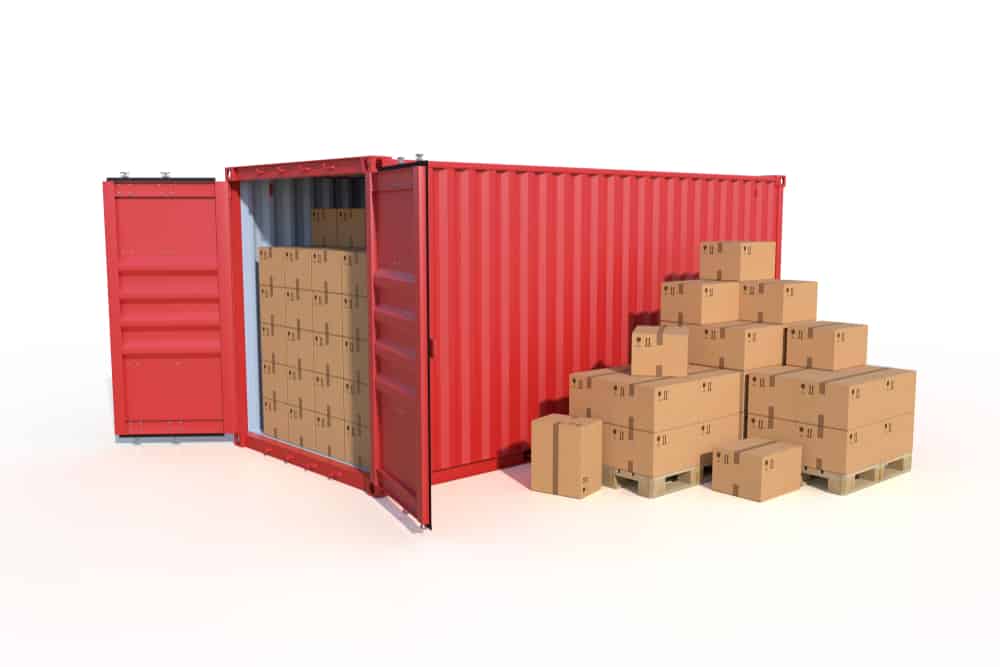
There are 5 main factors that affect how much you’ll pay to ship your goods. These are:
1. Mode of Transport
Mode of transport is by far the biggest factor affecting how much you’ll pay to ship a container. Sea freight (sending by boat) is the cheapest method, followed land (usually via trucks but sometimes via trains) with air freight (sending by plane) being the most expensive.
In most cases, air freight is prohibitively expensive so you’ll most likely use a combination of sea and land and/or just land only depending on where you’re shipping from and to.
2. Departure & Arrival Destination
This is the next most important factor. And while distance is important, what’s more important is the shipping volume (in both directions) on a given route. The more volume, generally speaking the lower the price, especially if there’s mismatch volumes between the origin and destination ports.
The best example of this is shipping anything to China which is usually extremely cheap. The reason is because there is a large volume of goods exported from China which require a large number of container ships. However, these ships often can’t be filled up for the return journey, and so offer great price. In fact, container rates to China are often among the lowest in the world.
3. Volume/Weight of Your Move
The bigger your moves the more it will generally cost. For most container shipping, volume is the most important factor rather than weight. Larger moves will require a 40ft container whereas smaller ones might be able to get away with using a smaller 20ft container. (see more below for more on the size differences between the two)
Weight only really comes in to play in a big way for air freight. It is charged primarily based on weight rather than volume. However, in most cases it’s not really suitable for a full move, but can be sued to ship a few key items.
4. Distance Of Your Move
As mentioned above the departure and arrival destinations of your move is one of the biggest factors affecting cost. Related to this is the distance of the move itself. Generally speaking closer moves are cheaper than longer distance ones.
That said volume of trade is still more important distance. For example, it’s usually significantly cheaper to ship a container from the UK to the US than from the UK to Canada even though the distances involved are roughly the same simply because there are ships going to the US than Canada due to the volume of trade.
5. Time of Year
Time of the year can also play a role in shipping costs. Globally, the summer high-season is the most expensive time to ship so is best avoided if possible.
Shipping to and from China is also more expensive around Chinese New Year (Jan and Feb) if you’re planning on shipping goods to and/or from there.
Container Size – 20ft vs 40ft
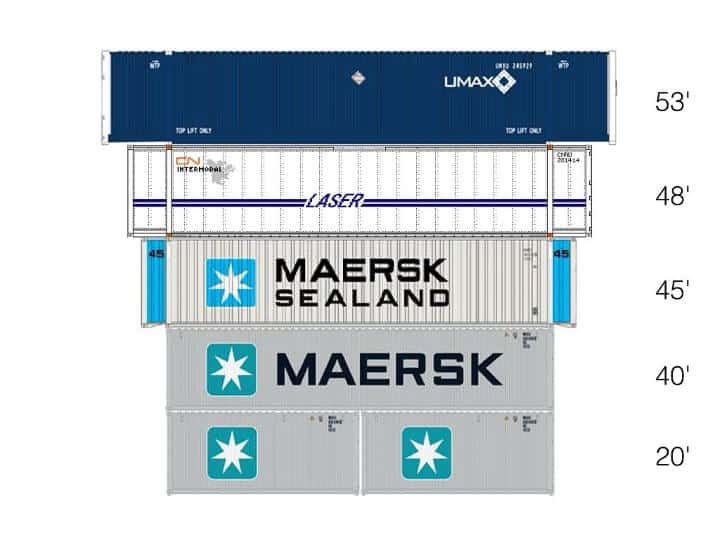
Other common variations include the 40ft high-cube container and the 45ft high-cube container, along with refrigerated containers and tankers for liquid.
However, for almost all international container moves, you’ll likely need either a 20ft or 40ft container. Let’s have a look at key stats for each type:
20ft Shipping Container
Suitable for: 1-2 bedroom moves or a car with only a few boxes.
Typical measurements:
Size (LxWxH): 19′ 10.5″ x 8′ 0″ x 8′ 6″ (6.1m x 2.4m x 2.6m)
Total internal volume: 1,169 ft³ (33.1 m³)
Net shipping load: 61,289 lb (28,200 kg)
40ft Shipping Container
Suitable for: 3-5 bedroom moves or a car plus a typical two bedroom move
Typical measurements:
Size (LxWxH): 40′ 0″ x 8′ 0″ x 8′ 6″ (12.2m x 2.4m x 2.6m)
Total internal volume: 2,385 ft³ (67.5 m³)
Net shipping load: 57,759 lb (26,600 kg)
Note: While a 40ft shipping container can typical hold about twice as much (in volume terms) as a 20ft one, it can actually carry less total cargo weight due to the weight of the container itself. Thus, if you’re looking to ship a car and a large household you may need more than 1 container.
20ft vs 40ft Side by Side Comparison
| 20ft Container | 40ft Container | |
|---|---|---|
| Min Internal Length | 19 ft 3 in (5.867 m) | 39 ft 4+3⁄8 in (11.998 m) |
| Min Internal Width | 7 ft 7+3⁄4 in (2.330 m) | 7 ft 7+3⁄4 in (2.330 m) |
| Min Internal Height | 7 ft 8+1⁄2 in (2.350 m) | 7 ft 8+1⁄2 in (2.350 m) |
| Internal volume | 1,169 cu ft (33.1 m3) | 2,385 cu ft (67.5 m3) |
| Common Max net load weight | 62,350 lb (28,280 kg) | 58,820 lb (26,680 kg) |
| Household Move Size | Up to 3 Bedroom House | 3+ Bedroom House |
| Number of Cars You Fit | Up to 1 | Up to 2 |
Less Container Load (LCL) vs Full Container Load (FCL)
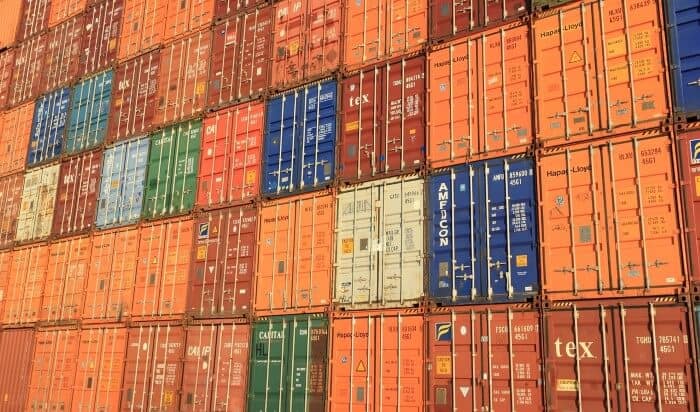
Another, set of term you may come across are LCL and FCL.
Less Container Load (LCL): This refers to moves or shipments that require less than a full container (either 20ft or 40ft). However, most companies will impose a minimum shipment volume, sometimes as low as 35.3 ft³ (1 m³). This can be the most cost effective option for very small moves, but it can often work out cheaper to just pay for a full container.
Full Container Load (FCL): This refers to moves or shipments where you pay for an entire shipping container. This means all your goods as shipped together as one and means no one else’s goods are shipping in your container. Shipping companies generally prefer when people pay for FCL as it makes the logistics at both ends much simpler.
FCL vs LCL: Which is Better?
| FCL | LCL | |
|---|---|---|
| Cost | Cheaper for large moves, more expensive for smaller ones | Cheaper for small moves, more expensive for larger ones |
| Speed | Faster | Slower, have to wait until container is filled |
| Move Size | Larger than than 500 cu ft (15 m3) or 2+ bedrooms | Smaller than 500 cu ft (15 m3) or up to 2 small bedrooms or 1 normal sized bedroom |
| Security | Container is all yours | Container is shared with others |
| Can be used to ship a car? | Yes | No |
Shipping Modes of Transportation: Land, Sea and Air
There are 3 ways to move freight internationally: by land, sea and air. All moves will involve at least some land transportation and some could involve all 3 methods. Here are the important things you need to know:
Land (Truck & Trains)
There are two types of land transportation used to ship containers: trucks and trains (via rail).
Truck
Virtually all moves will involve a truck. Domestic and international moves within the same continent will likely be done entirely by truck and usually by one company.
Whereas moves overseas can result in coordination between trucking companies. Any moving company you choose should make it clear how these costs break down and who will be responsible for what during the moving process.
Speed: Trucks can generally drive as quickly as road conditions will allow.
Costs: Moderate, but are unavoidable.
Examples moves: Domestic moves within the same city or country, United States to Canada or Mexico, Canada to the United States, United Kingdom to mainland Europe or Ireland (via ferry), and moves between countries in Europe.
Trains
The use of rail transportation to move shipping containers is also very common and can be much more cost effective than shipping via truck for long distance moves within a continent.
Speed: Depends on origin and destination, but usually slower than trucks.
Cost: For some journeys can cost less than using a truck.
Examples moves: Moves between the East and West coasts of North America, long distance moves between Eastern and Western Europe and some domestic moves within Australia.
Sea Freight
Sea freight or shipping via container ship is by far the cheapest way to move goods internationally but also the slowest. However, if you’re moving goods between continents, you normally have little choice but to send them via container ship.
Speed: Slow, depending on routes can take from a few days to several weeks.
Cost: Given the distances involved, very low
Example moves: United States to Australia, United Kingdom to the United States, South Africa to Canada, New Zealand to Australia.
Air Freight
Air freight is only rarely used in full household container moves due to the extremely high cost. Shipping via air can easily cost 10X as much as shipping via sea. Therefore, if you have some items you want to have with you as soon as you arrive in your new country, you should ship them via plane, but it’s much more cost effective to send the bulk of your goods via boat.
Speed: Very fast
Cost: Very high for large moves, but reasonable if only shipping a few boxes.
Example moves: Any two cities that have airports.
Loading & Delivery Options
Another important factor that affects cost is how you plan to load and deliver your shipping container. If you’re planning an FCL move you may have up to 3 options depending on your mover/freight forwarder/NVOCC:
1. Port to Port
This is the most basic option, and is what the rates at the top of the page are based on. Basically, with port to port shipping you are responsible for getting your goods to the origin port, the shipping company ships them to the destination port and then you’re responsible for getting them to your new house.
2. Drop & Fill
This is where the shipping company drops off a shipping container at your house and you fill it yourself. You may be able to use local movers and packers who work separately from the shipping company to help out.
Similarly this can be an option at the other end of your move, where the shipping company just drops the container at your new house and you are responsible for unloading it.
3. Door to Door Moves
By far the most common choice for people moving abroad is a complete door to door moving service. Depending on the options you choose your mover will arrange to have the container delivered to your house, packed, moved to port, shipped, moved to your new house and then unpacked.
If you don’t have much experience moving internationally and/or are shipping an LCL load this is the recommended option.
Other International Moving Costs
We listed international container shipping rates above, but these are by no means the only costs involved in any international move. When moving between countries you could face some of these costs as well.
Insurance: If you’re planing to ship your entire home overseas (or even just around the corner), it’s very important everything is insured. So make sure your shipping company has adequate maritime insurance. This will give you peace of mind that should anything get damaged or broken during your move, you’re not out of pocket.
Packing Costs: Most, if not all, international moving companies will make it a requirement that they pack your goods for you. While it may seem this is just way to add on an extra cost, there are good reasons for it. First, it helps prevent fraudulent insurance claims, which drives up the cost for everyone. Second, it can be requirement for taxes and duty (see below).
Taxes/Duty/Customs Charges: Before shipping your home overseas, it’s highly recommended that you do some research into how the country you’re moving to treats international moves. Some will impose taxes and/or duties on the value of the goods entering the country. It’s good to find out how much these are likely to be, before you move so you’re not faced with any nasty surprises.
Storage: Also, if you’re not planning to move abroad permanently it can be worth checking how much storage in your home country costs. This can sometimes work out cheaper than shipping goods overseas and then back again, especially if your home country also imposes taxes and duties on goods being shipped.
No reason to pay twice for the same things.
The Best International Container Shipping Deals With Free Quotes
With the glut of container ships on the market, now is a great time to get a good deal on international container shipping. However, basic rules of economics still apply and you’ll pay more for long distance moves and/or moves that involve less trafficked shipping routes.
In all cases the easiest way to ensure you get the best deal is to get a free moving quote. Your move is unique and so there’s really no way to give you a fully accurate estimate without getting more details from you about your move.
Fortunately, we’ve made it extremely simple. Just fill in the form at the top of this page with a few basic details, and we’ll get started trying to find you the best rate possible.
